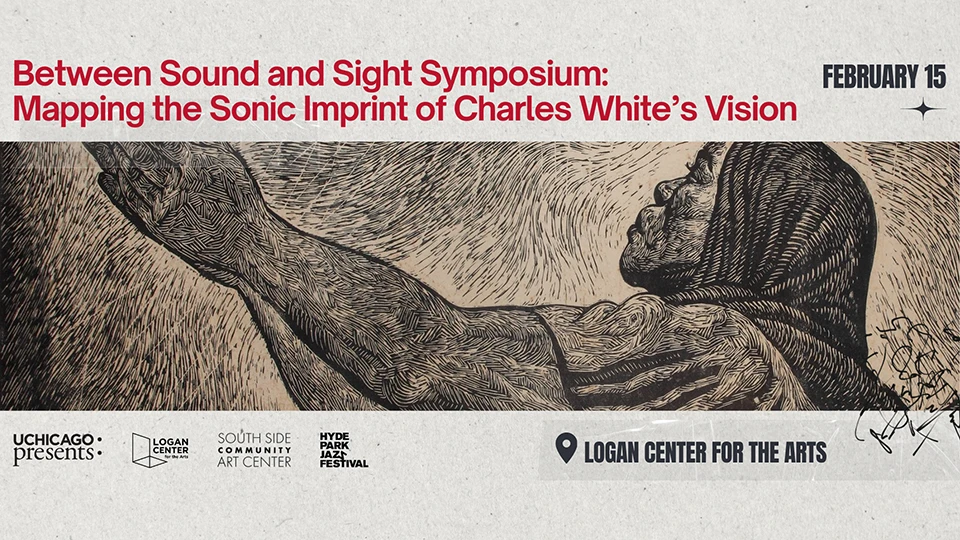The South Side Community Art Center, Hyde Park Jazz Festival, Logan Center for the Arts, and University of Chicago Presents invite you to Save the Date for Between Sound and Sight: Mapping the Sonic Imprints of Charles White’s Vision, a FREE day-long symposium offered in conjunction with the February 14th performance by pianist/composer Gerald Clayton of his original suite, White Cities: A Musical Tribute to Charles White at the Logan Center for the Arts. The symposium will explore sound, image, and history, offering a deeper engagement with Charles White’s multi-dimensional legacy. Discussions will consider White’s work with musicians and music media—such as illustrations for jazz album covers and film and television, as well as his paintings, etchings, and drawings of musicians—and ways in which his work and legacy continue to reverberate across the cultural landscape, particularly as an influence for contemporary artists.
On February 14th, the evening before the symposium, Gerald Clayton will perform his piece White Cities: A Musical Tribute to Charles White, honoring the connection between music and visual art that permeates Charles White’s artistic vision.
Free w/RSVP – Please note seating is limited – Reserve your space at the symposium here.
SYMPOSIUM SCHEDULE
Saturday, February 15, 2025 – Reva and David Logan Center for the Arts
11:00 AM Check-In, Welcome, and Keynote
Keynote: “Greetings from Altadena.” by Ian White
Charles White’s son and chief executive of The Charles White Archives
11:30 AM Panel One: Sounds of the Black Archive: Charles White’s Contributions to Film, Television, and Music Media
Throughout his career, Charles White contributed many illustrations for album jackets (mostly jazz recordings), books, television, and film. This panel will explore White’s work with/in music-related media. Examples include Vanguard Records album sleeve illustrations, an accompanying LP for the film Leadbelly directed by Gordon Parks, and illustrations for publications by Harry Belafonte and television collaborations. The discussion will include contemporary artists who also create and incorporate visual media into music contexts, or vice versa, for their projects or others.
Moderator: John Corbett
Panelists: Damon Locks, Cauleen Smith, and Ian White
12:30 PM Lunch Conversation
1:15 PM Panel Two: Visual & Musical Composition: Inspiration, Collaboration, & the Black Aesthetic
An element of inspiration for pianist/composer Gerald Clayton in creating his suite, White Cities: A Musical Tribute to Charles White, was to explore White’s visual composition and narrative in the mural Five Great American Negroes and respond musically. This panel will explore how visual artists and musicians find inspiration in visual and sound/music practice and how these influences are rendered compositionally and as points of convergence and meaning-making.
Moderator: Travis Jackson
Panelists: Gerald Clayton, Angel Bat Dawid, Douglas R. Ewart
2:30 PM Panel Three: Figures in Music: Charles White’s Portraits
Charles White’s portraits of musicians such as Leadbelly, Harry Belafonte, Bessie Smith, and Mahalia Jackson are some of his best-known works. This panel will explore White’s extraordinary portraiture of music-makers and how his relationships with some of these musicians and their work influenced his compositions and activism. In particular, the panel will consider White’s portraits of Black women in music.
Moderator: Melanie Herzog
Panelists: Daniel Schulman, Benjamin Jones, Tammy Kernodle
3:30 PM Symposium Closing
This project is supported by the Terra Foundation for American Art, the Logan Center Jazz Forever Fund, a gift of the Revada Foundation, and the Robert S. Guttman Family Charitable Fund. The symposium is part of Art Design Chicago, a citywide collaboration initiated by the Terra Foundation for American Art that highlights the city’s artistic heritage and creative communities. The White Cities Performance is presented with Chicago Jazz Magazine, DownBeat, Jazz Institute of Chicago, and WDCB 90.9 FM.
Image credit: Photo of Charles White work, Just a Walk with Thee, from the South Side Community Art Center Collection.




